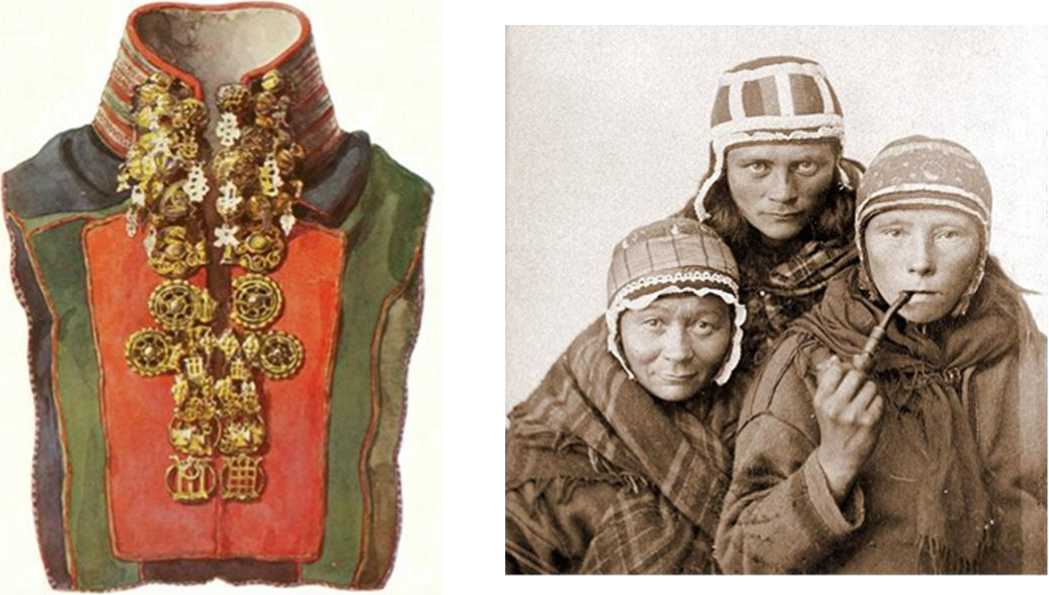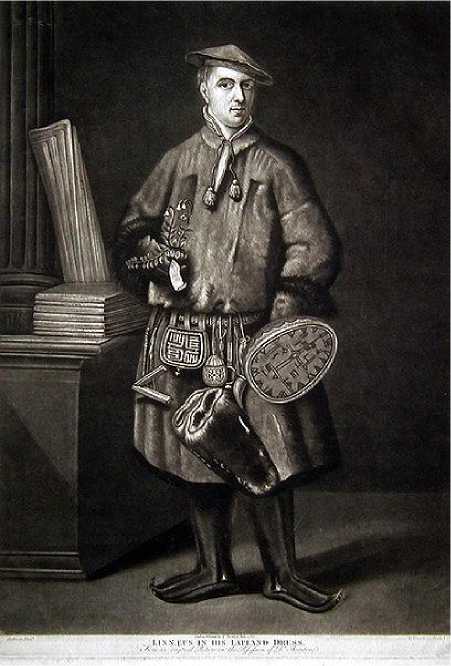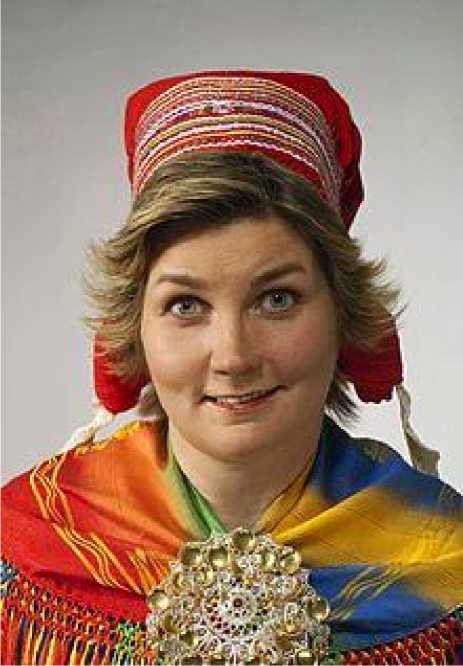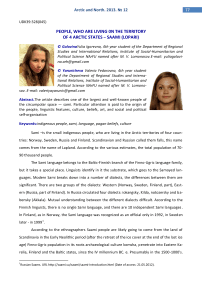People, who are living on the territory of 4 Arctic states — saami (lopari)
Автор: Golovina U.I.,Yarunicheva V.F.
Журнал: Arctic and North @arctic-and-north
Рубрика: Indigenous people of the Arctic and North
Статья в выпуске: 12, 2013 года.
Бесплатный доступ
The article describes one of the largest and well-known people of the circumpolar space — sami. Particular attention is paid to the origin of the people, linguistic features, culture, beliefs, art, and social and political self-organization.
Indigenous people, sami, language, pagan beliefs, culture
Короткий адрес: https://sciup.org/148319912
IDR: 148319912 | УДК: 39:328(045)
Текст научной статьи People, who are living on the territory of 4 Arctic states — saami (lopari)
Sami –is the small indigenous people, who are living in the Arctic territories of four countries: Norway, Sweden, Russia and Finland. Scandinavian and Russian called them falls, this name comes from the name of Lapland. According to the various estimates, the total population of 7090 thousand people.
The Sami language belongs to the Baltic-Finnish branch of the Finno-Ugric language family, but it takes a special place. Linguists identify in it the substrate, which goes to the Samoyed la n-guages. Modern Sami breaks down into a number of dialects, the differences between them are significant. There are two groups of the dialects: Western (Norway, Sweden, Finland, part), Eastern (Russia, part of Finland). In Russia circulated four dialects: iokangsky, Kilda, notozersky and ba-bensky (Akkala). Mutual understanding between the different dialects difficult. According to the Finnish linguists, there is no single Sami language, and there are 10 independent Sami languages. In Finland, as in Norway, the Sami language was recognized as an official only in 1992, in Sweden later - in 19991.
According to the ethnographers Saami people are likely going to come from the land of Scandinavia in the Early Neolithic period (after the retreat of the ice cover at the end of the last ice age) Finno-Ugric population in its roots archaeological culture komsha, penetrate into Eastern Karelia, Finland and the Baltic states, since the IV millennium BC. e. Presumably in the 1500-1000's.
BC. e. separation begins protosaamov from a single community of native speakers of the base. Py-theas the Greek historian in 325 BC, probably mention them when he writes about living far north of the Finnish people (pinnai). In his book "Germany" 98 g of n. e. Tacitus, speaking of the people of the Fenians (finni), seems to describe the daily life of ancient Sami. South of Finland and Karelia Sami migrated further north to escape the pervasive Finnish and Karelian colonization and, presumably, from the imposition of tribute. During the I millennium BC. e. they gradually came to the coast of the Arctic Ocean and reached the territories of their current residence.
The Sami are many sub-groups, respectively, there are differences in the culture and beliefs. Overall, however, for many centuries formed the ideological basis Sami based on pagan beliefs and its various forms. For them, were typical representation of a three-part structure of the universe, where the upper world was inhabited by the celestial gods, the middle world was of the earth, where people and animals lived in the lower afterlife souls of the dead lived and spirits patrons. In this case, all the Sami existed an idea of the stationary North Star served as a pillar that held the sky, apparently, by post or tree. This is indicated by its name translates as "the pillar of the world", "pillar of heaven," etc. clearly shows the three-dimensional world on a number of shamanic drums, but the interpretation of these images to some extent hypothetical, since the reliability of the materials received from the Sami themselves , this is not2.
Reconstruct the ancient pantheon of gods Sami extremely difficult: the very large number of their names and varied perceptions of them, at least in the form in which they went as far as the early explorers. This same god was Unnamed several options. But, as in other nations, the pantheon of the deities represented, symbolizing the elements of the nature (sun, thunder, fire, wind, etc.), as well as the patrons of the certain spheres of the human life (fertility, shamans, hunters, fishermen, etc.3.
The main forms of the pagan beliefs Sami - totemism, animism and fetish. In particular, it is considered to be the ancestor of the Sami reindeer, highly respected by the bear. We should also mention the fetishism, which is reflected in the cult seids. Seid or Seyda is a religious, sacred to the Sami object (a special place in the mountains, tundra, taiga, rock, stone prom, lake), and not necessarily a rock. Cult mission seids was varied and consistent with the full range of human needs. Thus, according to one of the Sami legend, fishermen go to sea, leaving part of his soul on the banks of the Stone seidh that in the event of their death it is not some kind of monster devoured. Some seids used sporadically, in connection with calendar events, or otherwise. Other seids were personified and were related to the specific person who may have had some of their sacred sites or stones. Fixed legend, according to which a stone has been accessed seidh people. Sometimes a stone Seydou sacrificed. Some of them could be approached only at certain times or could not come close, and it was impossible to approach women4.
In the connection with the ideas of the possible negative impact of the underworld in Saa-mi was developed ward of ritual and culture, which is reflected in the set of the rules and regulations during the wedding, a funeral, maternity practices. As in the culture of the majority of the indigenous people in the Arctic, was further developed shamanism. Shamans as a link between the three worlds can communicate with the spirits, help people, to protect and preserve it.

Pic. 1. Traditional Saami costumes. URL:

Pic. 2. The great Swedish naturalist Carl Linnaeus in the national Sami costume (Torke). Painting by Dutch artist Martin Hoffman (1737). URL: пос dressed_ as

Pic. 3. Aili Keskitalo, president of the Sami Parliament of Norway (2005-2007) in the traditional
Currently, the Saami pagan religious beliefs largely preserved in the form of the myths, legends, holidays and family rituals, symbols of the arts and crafts. The Christianization of the people began in XV-XVI centuries., so true of the traditional beliefs remained extremely low5. An analysis of the religious composition of the population of the Arctic areas of Norway, Sweden, Finland, Russia suggests that the predominant part of them is a native of Christian spiritual practice in its various forms.
Sami folk art is included decorative and applied arts, oral and musical creativity. There are several of the most developed species in the Sami arts and crafts: fur mosaics, murals and appliques on leather, birch bark weaving and manufacturing of the products made of birch bark, wood carving and bone, later appeared sewing beads, ornaments of the colorful fabrics, knitting pat-terns6.
The analysis of the current state of the culture allows us to conclude that the current attempts to revive the traditional crafts, musical art. In the early 1990's. composer Mari Boine was practically the sole on the throne of the Sami music. Now there are her followers. In Currently there are about 15-20 Sami ensembles. On the basis of the inverse images of Sami tents are cultural, entertainment and restaurant complex. However, the fundamentals of thetraditional Sami culture kept to a small extent. Holidays Sami mostly devoted milestone events related to the protection of their rights and interests (February 6 - International Day of the Sami). At the same time comply with the Sami and major holidays of the Christian calendar7.
Interpretation and musical folklore is represented the mythological epics, tales, legends, domestic narratives, songs. The characteristic features of the Sami songs is that they are devoid of the artistic images and are completely improvised with the specific content. They are executed throat singing, with the strong vibration voice. Sami studied music Vize notes that the songs of the historical or legendary and mythological character of the Saami did not exist. Usually sing songs associated with hunting, herding, courtship and marriage, a trip to the guests, etc.8.
The most important factor contributing to the preservation of the culture is the language of the people. The use of the Sami language in the school education in the northern Europe began only in the 1980s. Act of schooling in Finland (1985) suggests to 240 teaching hours per year for the teaching of the Sami language. Uniform literary language, generated on the basis of the north- ern dialect in 1978, allowed a single educational and cultural space for the Sami of Norway, Sweden and Finland. To date, the Sami language has official status of the state, in all three countries, there are laws on the Sami language governing its use in education, and record keeping.
The Sami language is taught at the elementary and the middle schools. However, the total number of the students in these countries does not exceed one thousand people in each of them. The study of the Sami language at an academic level possible in Sweden at the universities of Umeå and Uppsala. The statistical analysis shows that on average no more than 31-35% of Saami of Norway, Sweden and the command of the native language. As of 2001, 55% of voters Sami Parliament of Sweden did not speak the native language9.
The Sami have their own script Russia in 1933 began teaching in schools in the Sami language. In Murmansk trained staff of teachers for the Sami schools. However, in 1937 it was canceled. In 1982, writing in the Russian Sami was revived. Now Sami language is taught in the school in the village of Lovozero on the Kola Peninsula. An increasing number of the linguistic studies Sami languages, there were fiction. According to the materials of the 2002 census, the share command of the native language of Russian Saami 42.8%, compared with 1989 - 42.2%10 [1].
The basis of the socio-political self-organization of the Sami traditionally accounted community, called Sami, syyyt, siyt, consisting of individual families. Siyt usually occupied a certain territory, including the hunting grounds of the joint use of all its members. The members of the group carried siyta economic activity. Economic and administrative matters relating to the community, it was decided to solve the general meetings of heads of families. The number of member’s siyta numbered from 70 to 300 people11.
This type of the social organization for a long time been characterized by the Sami of the Kola Peninsula, as the Scandinavian Saami previously integrated into the community of those countries in whose territory they reside. By the middle of the XIX century almost all of them assimilated with other people.
At the same time the Sami Nordic early began to fight for their rights. In 1948, for the purpose of promoting the interests of the Sami reindeer herders was formed by one of the oldest organizations of the Sami in Norway - «The Sami Reindeer Herders' Association in Norway (NRL)». This organization, founded in 1968, was aimed at improving the situation of the human rights and the protection of the Sami as an indigenous people. Norwegian Sami Union «The Norwegian Sami Union (SLF)», founded in 1979, was intended to protect and develop the Sami language. At the same time in the middle of the twentieth century. begins the process of coordinating the efforts of the Sami of the Northern Europe for the protection of his interests. In August 1956 a second conference Sami, which was held in Norway, was created by the North Saami Council 12. Saami Council continues its work today, implementing it on the basis of decisions made by the Sami conferences. Saami Council is a single cultural-political body Sami of Norway, Finland, Sweden and Russia. Its main purpose is to protect the interests of the Sami as a people, to strengthen the Sami community across borders and work to ensure that in the future Sami recognized as a people, their cultural, political, economic and social rights. However, in the formulation of the objectives is clearly discernible trend of the separatism.
In the 1973-1993 years. in the Nordic countries have been set up Sami Parliaments (Finland - in 1973, Norway - in 1987, Sweden - c. 1993)13. In Russia, on 11-12 December 2010 II Congress of the Saami of the Murmansk region approved a temporary representative body of the Sami - Sami Parliament [2]. In the contrast to the Nordic Saami parliaments, it does not have legislative initiative.
In the general, the Sami have preserved and continue to revive the basics of their own cultural identity. But at the same time it is one of the nations most integrated in the current political, economic and cultural processes of their countries of the residence. Probably will not be an exaggeration to claim that the modern Sámi culture is the so-called kitsch, when traditional forms of folk culture is embedded modernized sense
Список литературы People, who are living on the territory of 4 Arctic states — saami (lopari)
- Sokolova Z.P., Stepanov V.V. Indigenous People. Population dynamics of Population Censuses / Ethnographic Review. 2007. Number 5. p. 75-95.
- Lukin Y.F. A performance of the ethnic and cultural landscape of the Arctic in the global and regional dimensions / / // ArcticandNorth. 2011. №1. p 77.URL: http://narfu.ru/aan/ article_index_years.php?ELEMENT_ID=9878
- Saams. URL: http://finugor.ru/node/877 (Date of access 07.12.2012).


